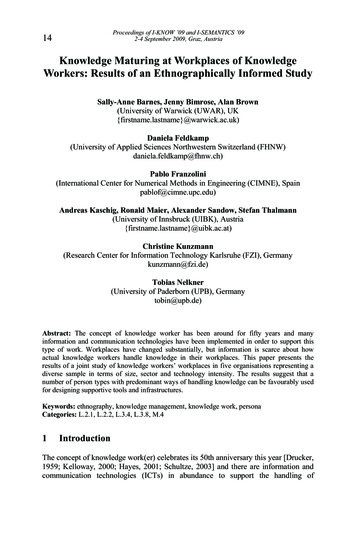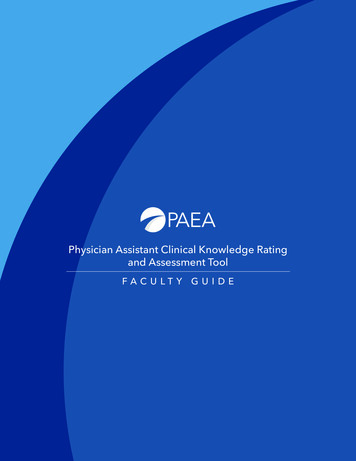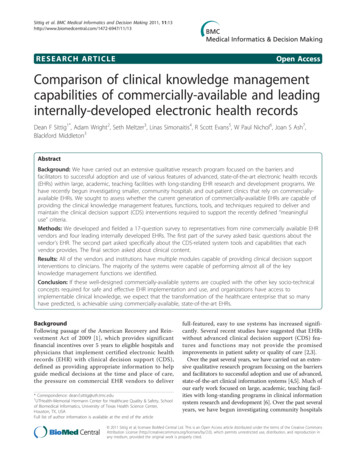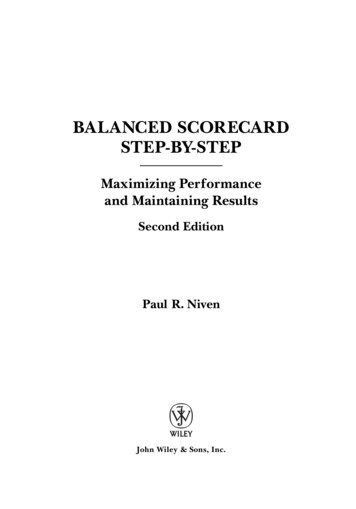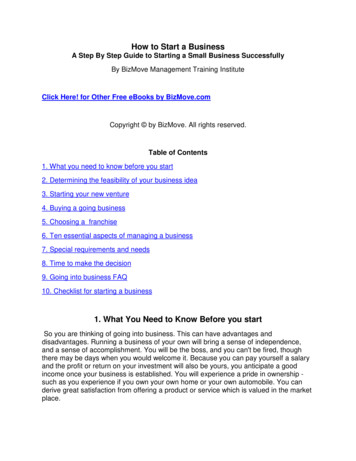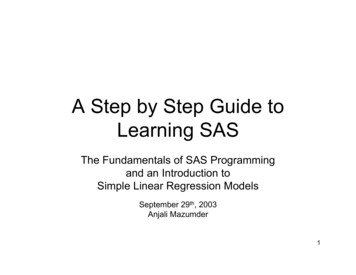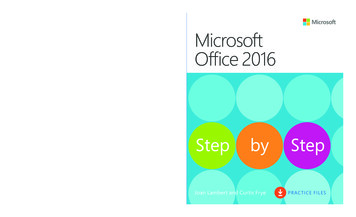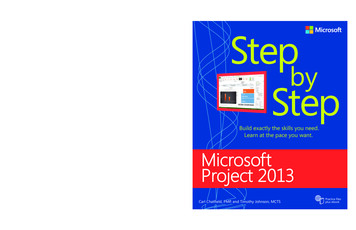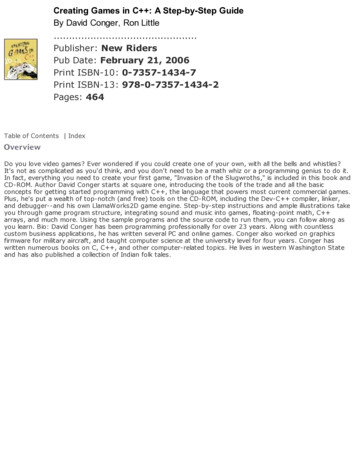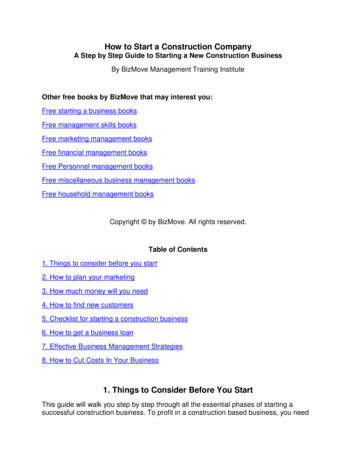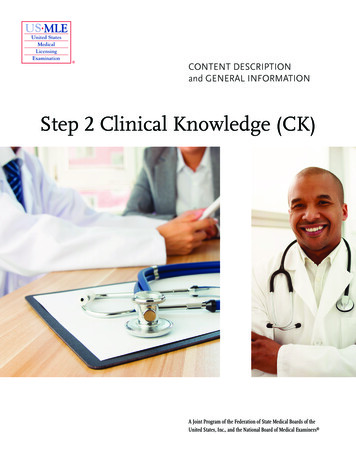
Transcription
CONTENT DESCRIPTIONand GENERAL INFORMATIONStep 2 Clinical Knowledge (CK)A Joint Program of the Federation of State Medical Boards of theUnited States, Inc., and the National Board of Medical Examiners
This booklet was updated March 2019.Copyright 2019 by the Federation of State Medical Boards of the United States, Inc. (FSMB), and the NationalBoard of Medical Examiners (NBME ). All rights reserved. The United States Medical Licensing Examination(USMLE ) is a joint program of the FSMB and the NBME.1
CONTENTSIntroduction 3Examination Format . 3Purpose and Design of the Examination . . 4Content Description . . .5Content Outline . . 5Table 1: Step 2 CK System Specifications .6Physician Tasks/Competencies . . 7Table 2: Step 2 CK Physician Tasks/Competencies Specifications . 7Table 3: Step 2 CK Discipline Specifications . . 7Step 2 Clinical Knowledge MCQ Content and Competency Examples . 82
INTRODUCTIONThis booklet will help you prepare for the Step 2 Clinical Knowledge (Step 2 CK) component of theUnited States Medical Licensing Examination (USMLE ).Practice materials, which include Sample Test Items (PDF) and simulated web-based Tutorial andPractice Test Items, tutorials, as well as other informational materials are available at the USMLEwebsite www.usmle.org. Examinees must also read the USMLE Bulletin of Information atwww.usmle.org/bulletin.IMPORTANT: The term item is used to describe a test question in any format. You must run the web-based Tutorial and Practice Test Items to become familiar with thetest software prior to your test date. The tutorial provided at the beginning of the Step 2 CK Examination has fewer screens andless detailed information than the Step 2 CK web-based Tutorial and Practice Test Items onthe USMLE website. The web-based Tutorial and Practice Test Items on USMLE website include single multiplechoice questions, a sequential set of multiple-choice questions, a scientific abstract (asummary of an experiment or clinical investigation, accompanied by two or morequestions), and items with audio or video findings.Please visit the USMLE website www.usmle.org often to view announcements, regarding changesin test delivery software, and to access updated practice materials. You must obtain the mostrecent information before taking any USMLE examination.EXAMINATION FORMATStep 2 CK consists of multiple-choice questions (MCQs) prepared by examination committeescomposed of prominent faculty members, teachers, investigators, and clinicians who make up theUSMLE Test Material Development Committees. All committee members have recognizedexpertise in their respective fields. They are selected to provide broad representation from theacademic, practice, and licensing communities across the United States and Canada.Step 2 CK is a one-day examination. It is divided into eight 60-minute blocks and administered inone 9-hour testing session. The number of questions per block on a given examination will varybut will not exceed 40. The total number of items on the overall examination will not exceed 318.3
The examination also includes a minimum allotment of 45 minutes of break time and a 15-minuteoptional tutorial. The amount of time available for breaks may be increased by finishing a block oftest items or the optional tutorial before the allotted time expires.PURPOSE AND DESIGN OF THE EXAMINATIONStep 2 CK assesses an examinee’s ability to apply medical knowledge, skills, and understanding ofclinical science essential for the provision of patient care under supervision and includes emphasison health promotion and disease prevention. Step 2 CK ensures that due attention is devoted toprinciples of clinical sciences and basic patient-centered skills that provide the foundation for thesafe and competent practice of medicine under supervision.Test questions focus on the principles of clinical science that are deemed important for thepractice of medicine under supervision in postgraduate training.4
CONTENT DESCRIPTIONThe content description that follows is not intended as a curriculum development or study guide,but rather models the range of challenges that will be met in the actual practice of medicine. Itprovides a flexible structure for test construction that can readily accommodate new topics,emerging content domains, and shifts in emphasis. The categorizations and content coverage aresubject to change. The best preparation for the examination is broad-based learning thatestablishes a strong general understanding of concepts and principles in the basic and clinicalsciences.Content OutlineAll USMLE examinations are constructed from an integrated content outline. The outline isavailable on the USMLE website (www.usmle.org/pdfs/usmlecontentoutline.pdf). Content isorganized according to general principles and individual organ systems. Test questions areclassified into one of 18 major categories, depending on whether they focus on concepts andprinciples that are applicable across organ systems or within individual organ systems. Most organsystems are subdivided into normal and abnormal processes. They include subcategories ofspecific disease processes. In most instances, knowledge of normal processes is evaluated in thecontext of a disease process or specific pathology. Sections focusing on individual organ systemsare subdivided according to normal and abnormal processes, including principles of therapy.Not all topics listed in the content outline are included in every USMLE examination. Overallcontent coverage is comparable in the various examinations that will be administered to differentexaminees for each Step. The Step 2 CK examination covers content of specific disease processesor pathology. The Step 2 CK systems specifications are listed in Table 1.5
Table 1: Step 2 CK System Specifications*SystemGeneral Principles of Foundational Science**Immune SystemBlood & Lymphoreticular SystemBehavioral HealthNervous System & Special SensesMusculoskeletal Sys/Skin & Subcutaneous TissueCardiovascular SystemRespiratory SystemGastrointestinal SystemRenal & Urinary System & Male ReproductivePregnancy, Childbirth & the PuerperiumFemale Reproductive System & BreastEndocrine SystemMultisystem Processes & DisordersBiostatistics & Epidemiology/Population Health / Interpretation ofMedical LiteratureSocial Sciences: Legal/Ethical Issues & Professionalism/Systemsbased Practice & Patient SafetyRange, 114–84–84–84–85–91-53–7*Percentages are subject to change at any time. See the USMLE website (www.usmle.org) for themost up-to-date information.**The General Principles category for the Step 2 CK examination includes test items concerningthose normal and abnormal processes that are not limited to specific organ systems. Categoriesfor individual organ systems include test items concerning those normal and abnormal processesthat are system-specific.6
Physician Tasks/CompetenciesAn additional organizing construct for Step 2 CK design is physician tasks and competencies. Eachtest item is constructed to focus on assessing one of the competencies listed in Table 2. Detailedinformation about the physician tasks and competencies outline is available at the USMLEwebsite (www.usmle.org/pdfs/tcom.pdf).Table 2: Step 2 CK Physician Task/Competencies Specifications*CompetencyMedical Knowledge: Applying Foundational ScienceConceptsPatient Care: Diagnosis History/Physical Examination Laboratory/Diagnostic Studies Diagnosis Prognosis/OutcomePatient Care: Health Maintenance/Disease Prevention &SurveillancePatient Care: Management Pharmacotherapy Clinical Interventions Mixed ed Practice & Patient SafetyPractice-based Learning & ImprovementRange, %12–1640–507-1122-273-7*Percentages are subject to change at any time. See the USMLE website (www.usmle.org) for themost up-to-date information.Each Step 2 CK examination covers content related to the traditionally defined disciplines listed inTable 3.Table 3: Step 2 CK Discipline Specifications*DisciplineRange, yPediatricsObstetrics & GynecologyPsychiatry*Percentages are subject to change at any time. See the USMLE website (www.usmle.org) for themost up-to-date information.7
STEP 2 CLINICAL KNOWLEDGE MCQ CONTENT AND COMPETENCY EXAMPLESExamples of Multiple Choice Questions (MCQs) focused on each of the competencies and samplesof topics from different areas of the content outline are shown below.Competency: Medical Knowledge/Scientific Concepts: Applying Foundational Science ConceptsContent Area: Cardiovascular SystemA 55-year-old man has had crushing substernal chest pain on exertion over the past 6 weeks. Hehad a myocardial infarction 2 months ago. He takes nitroglycerin as needed and one aspirin daily.He has smoked two packs of cigarettes daily for 30 years. Examination shows normal heart soundsand no carotid or femoral bruits. Treatment with a β-adrenergic blocking agent is most likely toimprove his symptoms due to which of the following mechanisms?(A)(B)(C)(D)Decreasing myocardial contractilityDilating the coronary arteriesPeripheral vasodilationPreventing fibrin and platelet plugsAnswer: ACompetency: Patient Care: Diagnosis - Laboratory/Diagnostic StudiesContent Area: Behavioral HealthA 17-year-old girl comes to the physician for an examination prior to entering college. She reportsthat she feels well but is nervous about leaving home for the first time. She states that she hastried to diet to improve her appearance but that food restriction often "backfires" because shebecomes hungry and then engages in episodes of binge eating. She reports a loss of control duringthese episodes, saying "It's like I stop thinking at all and before I know it, I have eaten two pizzas."She induces vomiting several times during each binge and has developed a pattern of binging andpurging every evening. She has no history of serious illness and takes no medications. She is 165cm (5 ft 5 in) tall and weighs 57 kg (125 lb); BMI is 21 kg/m2. Vital signs are within normal limits.Physical examination shows dry mucous membranes, erosion of enamel on the lingual surface ofthe front teeth, and hypertrophy of the parotid gland. Serum studies are most likely to showwhich of the following sets of findings in this swer: B8
Competency: Patient Care: DiagnosisContent Area: Musculoskeletal Sys/Skin & Subcutaneous TissueA hospitalized 57-year-old man has had severe progressive pain in his left knee since awakening 2hours ago. He was admitted to the hospital 2 days ago for an acute myocardial infarction. Cardiaccatheterization showed occlusion of the left anterior descending artery, and he underwentplacement of a stent. Current medications include aspirin, metoprolol, lisinopril, simvastatin,clopidogrel, and heparin. Vital signs are within normal limits. Examination of the knee shows alarge effusion. The knee is hot to touch and erythematous. He holds the knee in 30 degrees offlexion; the pain is exacerbated with further flexion or extension. Laboratory studies show:HematocritLeukocyte countSerumCa2 Urea nitrogenCreatinineAlbumin40%13,000/mm39.2 mg/dL15 mg/dL1.0 mg/dL3.6 g/dLAn x-ray of the left knee shows calcification of the synovium. Which of the following is the mostlikely diagnosis?(A)(B)(C)(D)(E)(F)Deep venous c arthritisAnswer: E9
Competency: Patient Care: Management -Clinical InterventionsContent Area: Female Reproductive & BreastA previously healthy 27-year-old nulligravid woman comes to the emergency department becauseof a 2-day history of moderate-to-severe pain and swelling of the left labia. She is sexually activeand uses condoms inconsistently. Her temperature is 37.2 C (99 F), pulse is 92/min, respirationsare 18/min, and blood pressure is 115/75 mm Hg. Pelvic examination shows a 4 x 3-cm, tender,fluctuant mass medial to the left labium majus compromising the introital opening. Which of thefollowing is the most appropriate next step in management?(A)(B)(C)(D)(E)Administration of intravenous metronidazoleAdministration of intravenous penicillin GUltrasound-guided needle aspiration of the massIncision and drainageVulvectomyAnswer: DCompetency: Practice-based LearningContent Area: BiostatisticsA cohort study is conducted to compare the incidence of adverse effects of a recently approvedantihypertensive pharmacotherapy with that of conventional therapy. A total of 20,000 patientsare enrolled. Twelve thousand are prescribed the recently approved therapy, and 8,000 areprescribed conventional therapy. Patients in the study and control groups are matched forbaseline blood pressure, age, and gender. Data are collected from the records of the patients'ongoing clinical care. Results show that those receiving the newly approved treatment have twicethe incidence of fatigue compared with those receiving the conventional treatment. The resultsare statistically significant (p 0.01). Which of the following potential flaws is most likely toinvalidate this study?(A)(B)(C)(D)Publication biasSelection biasType I errorType II errorAnswer: B10
Competency: ProfessionalismContent Area: Social SciencesThree days after hospitalization for diabetic ketoacidosis, an 87-year-old woman refuses insulininjections. She says that her medical condition has declined so much that she no longer wishes togo on living; she is nearly blind and will likely requir
United States Medical Licensing Examination (USMLE . General Principles of Foundational Science** 1–3 Immune System 4–6 Blood & Lymphoreticular System 4–7 Behavioral Health 6–10 Nervous System & Special Senses 6–10 Musculoskeletal Sys/Skin & Subcutaneous Tissue 6–10 Cardiovascular System 8–12 Respiratory System 7–11 Gastrointestinal System 7–11 Renal & Urinary System & Ma

